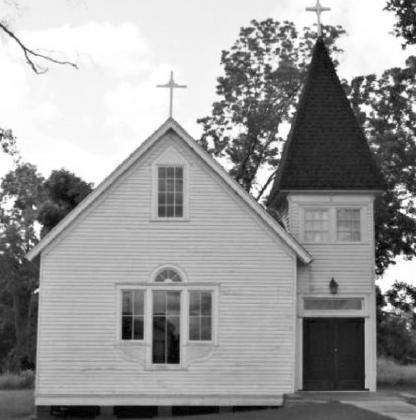ST. STEPHEN’S EPISCOPAL CHURCH
In a Short History of the Protestant Episcopal Church in Texas, a congregation named “All Faith Church” is noted as having been admitted to union with the Diocese of Texas in 1852. This church congregation did not have a pastor nor a permanent building in which to worship. During the next thirty-five (35) years, services were held occasionally by visiting clergy from Houston and other towns. The Reverend Robert B. Cross of the Diocese of New York reported having officiated at Liberty in May 1857. Bishop Alexander Gregg, first Bishop of Texas, held services in Liberty during December 1865, and promised to help arrange for a part tie missionary to serve. From the time of Bishop Gregg’s visit, Liberty was carried on a list of missions in the statistical tables of parishes and missions through 1868. After that time there are no missions recorded. In 1893, the Liberty mission was formally organized as “St. Mary’s” and admitted to the Council under that name in 1897. The Liberty mission was variously known and listed as “St. Peter’s.” “St. John’s” and Trinity Mission. Mission services increased as the congregation grew, and activity increased. In 1896, the Liberty Vindicator reported “Rt. Rev. Dr. Kinsolving, Bishop of Texas, visited Liberty and confirmed a class of seven in Bailey’s Hall….” and “Dr. Jefferies……had been here for some days baptized several of those who were confirmed.” Records show services were held at Bailey’s Hall and the Methodist Church in Liberty. By 1896, members of the congregation were anxious to have a building of their own and efforts were started to raise funds for a church building. Many members of the congregation combined their talent and energy to produce entertaining social events in the community to raise funds for the new church. News articles during this period indicate numerous events such as lawn parties, Japanese Tea, dramatic productions, ice cream supper and a dinner to benefit the building program. One such event was the combined effort of the ladies of the Episcopal and Methodist congregations to produce a dinner for 150 people at 25-cents per plate. Deeds to Lot #3, Inner Block 20 in the City of Liberty in 1859 and in 1898 confirmed ownership to the Episcopal Church for a site for a church building. Construction of a church commenced the week of April 8, 1898, as mentioned in the Liberty Vindicator, “….work was begun on our Episcopal Church this week and will be pushed to completion by contractor, Mr. J.T. Firth.” The one-story wood frame structure consisted of a main section and attached belfry-entrance. The main section is approximately 40’ by 22’; the belfry-entrance area adds an area of approximately 8’ by 8’ to the front of the structure. A small entry porch on the south side led to the front double doors of the belfry-entrance section. A glass window ran horizontally above the double doors. On the south side of the church were two (2) crosses, one atop the belfry and one atop the front main section of the church. The church was consecrated on May 28, 1899, by Bishop Kinsolving as the “Church of the Intercession.” In 1952, the name was changed due to confusion with the Catholic Church to “St. Stephen’s” and in 1953, the Episcopal Council admitted the church as a self-supporting parish. The original structure served Episcopalians in the city of Liberty and surrounding area for over 75 years. It was the oldest church building in the city and had been in continuous use for worship until it was moved in 1995 to the grounds of the Sam Houston Regional Library and Research Center to be used as a museum. The church has been restored and sits among other historical structures, the Norman House (1883) and the Gillard-Duncan House (1848). The church and other buildings enhance the interpretation of the Southeast Texas collection and historical documents at the Center. The original church building serves as an important link in defining the development and growth of the area in the 19th century.
The history of St. Stephen’s Episcopal Church continues today in a much larger brick building with lovely stained-glass windows on the original site. The vision of the early congregants remains an integral part of the city of Liberty as it did in 1852.
Texas Historical
Commission Subject
Marker 19772041 Trinity
Avenue, Liberty, TX

